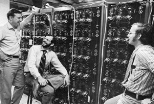President Emeritus Paul E. Gray has been associated with MIT's Department of Electrical Engineering and Computer Science for more than 50 years, starting as an undergraduate who majored in EECS. He returned to the department faculty in 1992 after retiring as chair of the Corporation, and he continues to teach undergraduates.
In an introduction to "A Century of Electrical Engineering and Computer Science at MIT" (MIT Press, 1985), Gray listed "the cardinal principles" that shape the department:
- "Steadfast attention to the importance of stimulating teaching and of broadening and deepening the students' horizons. Few other departments have known so many uncommonly gifted teachers. This is no accident. In its collective concern for quality and effectiveness in teaching and learning, the fact that people are the principal objects of this department's efforts is consistently evident.
- "A willingness, indeed an insistence, not only to connect with real problems and important educational and technical issues of today--the problems of industry, the needs of society, the priorities of government--but to anticipate the needs of tomorrow through imaginative research programs carried out by student-professor partnerships.
- "A complete acceptance of the doctrine that teaching and research play mutually reinforcing roles. The department's curricula have been steadily transformed and strengthened by the regular infusion of knowledge and insights gained from its research activities.
- "An overriding concern for quality in all that is done. The influence and strength of the department result in large measure from its insistence that every enterprise, every new development, be a best effort.
"These qualities, it seems to me, are hallmarks not only of the department but also of MIT, and they set a high standard for our future."
A version of this article appeared in MIT Tech Talk on May 21, 2003.






